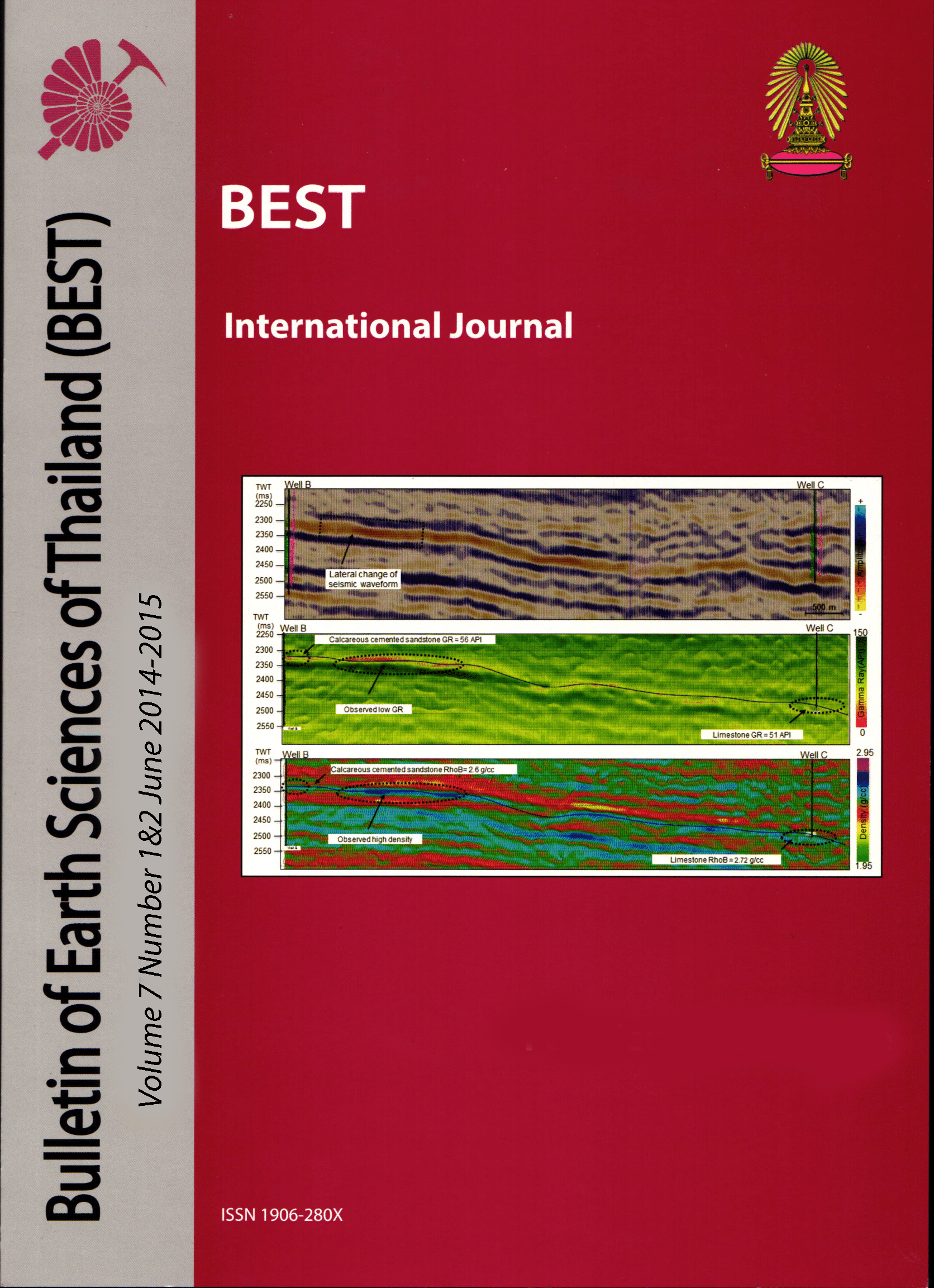PATTERNS OF DISPLACEMENT ALONG BOUNDARY FAULTS: IMPLICATION FOR BASIN EVOLUTION IN NAKHON BASIN, GULF OF THAILAND
Main Article Content
Abstract
Nakhon basin is located in the western portion of the Gulf of Thailand. The northern part of the basin is oriented NW-SE and the southern part is oriented N-S. The rifting started in Eocene?/Early Oligocene along NW-SE oriented faults. According to displacement-distance (D-d) profiles, the Western Boundary fault displays three individual fault segments and Eastern Boundary fault displays two segments. These are also indicated by the distinct strikes of fault segments, the abrupt decrease in throw and strata thickness from depocenters to their tips and the location of transverse anticline. Sedimentation was controlled by main Western Boundary fault and Eastern Boundary fault until Late Oligocene. Thermal subsidence may play role during Early Miocene to Middle Miocene. Inversion anticlines were observed along Eastern Boundary fault of the northern part of the Basin. This local feature is interpreted as being caused by compression at the tip of the oblique-striking fault segments due to oblique extension with a dextral left stepping compression. Extensional fault systems in study area were influenced in a number of ways by oblique pre-existing fabrics as indicated by oblique orientation of intrabasinal faults and zigzag pattern of regional faults. This influence of preexisting fabric is associated with Three Pagoda Fault zone which is cross cutting the study area.
Article Details

This work is licensed under a Creative Commons Attribution-NonCommercial-NoDerivatives 4.0 International License.
Copyright © 2008 Department of Geology, Faculty of Science, Chulalongkorn University. Parts of an article can be photocopied or reproduced without prior written permission from the author(s), but due acknowledgments should be stated or cited accordingly.
References
Kornsawan, A., & Morley, C. K. (2002). The Origin and Evolution of Complex Transfer Zones (Graben Shifts) in Conjugate Fault Systems around the Funan Field, Pattani Basin, Gulf of Thailand. Journal of Structural Geology, v.24, p. 435-449.
Morley, C. K., and A. Racey, 2011, Tertiary stratigraphy, in M. F. Ridd, A. J. Barber, and M. J. Crow, The Geology of Thailand: London, Geological Society, p. 223-271
Morley, C. K., Gabdi, S., & Seusutthiya, K. (2007). Fault Superimposition and Linkage Resulting from Stress Changes during Rifting: Examples from 3D Seismic Data, Phitsanulok Basin, Thailand. Journal of Structural Geology, v.29, p.646-663.
Morley, C. K. (1999). Patterns of Displacement Along Large Normal Faults: Implications for Basin Evolution and Fault Propagation, Based on Examples from East Africa. AAPG Studies in Geology, No.4, p. 151-160.
Morley, C. K. (2007). Variations in Late Cenozoice-Recent Strike-Slip and ObliqueExtensional Geometries, within Indochina: The Influence of Pre-Existing Fabrics. Journal of Structural Geology, v.29, p.36-58.
Peacock, D.C.P., 2002, Propagation, interaction and linkage in normal fault systems: Earth-Science Reviews, v. 58, no. 1, p. 121–142.
Watcharanantakul, R., & Morley, C. K. (2000). Syn-Rift and Post-Rift Modelling of the Pattani Basin, Thailand: Evidence for a Ramp-Flat Detachment. Marine and Petroleum Geology, p.937–958.


